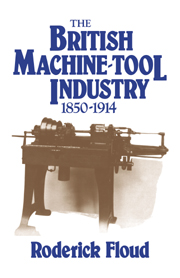Book contents
- Frontmatter
- Contents
- List of tables, figures and appendices
- Preface
- Introduction
- 1 The engineering industries
- 2 The technical history of machine tools, 1850–1914
- 3 The machine tool industry: structure and explanation
- 4 International trade in machine tools
- 5 Greenwood and Batley: history, records and methods
- 6 Greenwood and Batley: markets and prices
- 7 Greenwood and Batley: production
- Conclusion
- List of works cited
- Notes
- Index
5 - Greenwood and Batley: history, records and methods
Published online by Cambridge University Press: 02 December 2009
- Frontmatter
- Contents
- List of tables, figures and appendices
- Preface
- Introduction
- 1 The engineering industries
- 2 The technical history of machine tools, 1850–1914
- 3 The machine tool industry: structure and explanation
- 4 International trade in machine tools
- 5 Greenwood and Batley: history, records and methods
- 6 Greenwood and Batley: markets and prices
- 7 Greenwood and Batley: production
- Conclusion
- List of works cited
- Notes
- Index
Summary
In the preceding chapters, the English machine tool industry has been treated very much in aggregate terms. With the exception of some consideration of individual firms in chapter 3, the performance of the industry at home and abroad, and its structure, has been treated from aggregate sources, and even the evidence presented from the history of individual firms has been treated as helping to build a general picture of the industry and of its growth over the whole period from 1850 to 1914.
In this and the following chapters, by contrast, attention is concentrated on the experience of a single machine tool producer, the engineering firm of Greenwood and Batley of Leeds. Such a concentration makes it possible to answer many questions about the industry which cannot be answered on an aggregate level, questions of the nature of demand for machine tools facing individual firms, of the methods of production, of accounting methods, entrepreneurial behaviour and relationships with other firms and with customers. For reasons of space, several of these questions can be treated only scantily or not at all; an example of the latter is the history of labour relations and the labour force. Instead, attention is concentrated on the sales made by the firm and on its relationships with customer firms and industries, and, in chapter 7, on its efficiency as a producer. This is preceded, in this chapter, by a short history of the firm and by a discussion of the records which it left, and which make it possible and profitable for it to be studied in such great detail.
- Type
- Chapter
- Information
- The British Machine Tool Industry, 1850–1914 , pp. 120 - 144Publisher: Cambridge University PressPrint publication year: 1976



